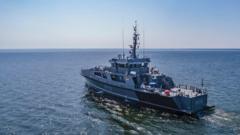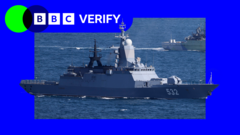Estonia's response comes after accusations of sabotage regarding undersea cables, prompting NATO to enhance its military presence in the Baltic Sea.
Estonia Deploys Navy Ship to Safeguard Undersea Power Cable Amid Sabotage Fears

Estonia Deploys Navy Ship to Safeguard Undersea Power Cable Amid Sabotage Fears
Estonia sends patrol boat Raju to protect vital Estlink 1 following undersea cable damage blamed on Russian activities.
Estonia has activated its naval forces to safeguard the Estlink 1 undersea power cable after damage was reported to the Estlink 2 cable, with allegations pointing towards Russian interference. The patrol boat Raju has been dispatched to prevent any further incidents that may jeopardize the crucial power supply between Estonia and Finland. The Finnish coast guard has boarded the oil tanker Eagle S, identified as a suspect in the cable damage, moving it into safer waters.
NATO has announced plans to increase its military presence in the Baltic Sea, coinciding with Estonia's initiative. "We are taking necessary steps to ensure the security of our infrastructure," remarked Estonian Defence Minister Hanno Pevkur, who expressed hope that Finland would participate in the protective operation.
As the situation unfolds, NATO Secretary General Mark Rutte confirmed discussions with Finland's President Alexander Stubb regarding increased defense collaboration. Estonia's Prime Minister Kristen Michal reaffirmed the nation's commitment to protect its interests and suggested invoking Article 4 of the NATO Treaty if the situation escalates.
The Estlink 2 cable, spanning 170 kilometers, has been a vital energy lifeline, and this recent damage poses a severe threat to the national power supply, further exacerbated by past incidents of undersea cable cuttings in the region. Following inspections, experts have warned that repairs to the Estlink 2 could extend until July 2025.
The ongoing tension in the Baltic region has been further complicated by the activities of the so-called Russian "shadow fleet," including ships like the Yi Peng 3 and Eagle S, which are believed to be operating under the radar to circumvent international sanctions implemented after Russia's invasion of Ukraine.
In light of this evolving threat landscape, both Estonia and Finland are exploring options for greater security, while the EU considers sanctions on entities linked to this shadow fleet, which they say threatens European security and environmental safety. Estonia's leaders assure the public that there are ample backup systems to ensure power supply continuity despite the risks involved in protecting underwater infrastructure.























